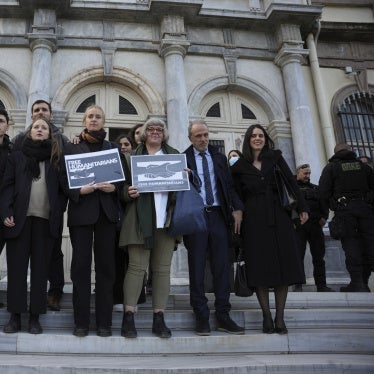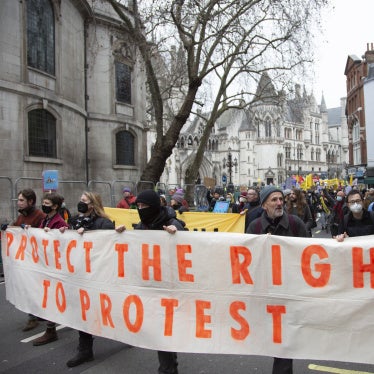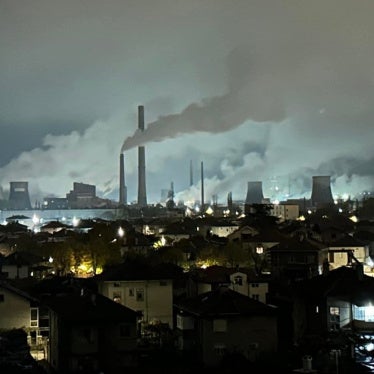In a report released today, Human Rights Watch documents the initial stages of the current conflict in Kosovo, and the pattern of Yugoslav government atrocities against ethnic Albanians in the region from February to early September 1998. workers.
The report provides detailed evidence of serious breaches of international law, showing that Serbian special police and Yugoslav army units have executed civilians, systematically destroy ed civilian property, and attacked humanitarian aid workers.
The report also describes how the ethnic Albanian insurgency, the Kosova Liberation Army (KLA), has violated the laws of war by taking civilian hostages and committing summary executions. While emphatically condemning these acts, the report also notes that they have occurred on a lesser scale than those attributable to government forces.
"It's been clear for seven months that the government is conducting a brutal war against civilians in Kosovo," said Holly Cartner, executive director of the Europe and Central Asia division of Human Rights Watch. "But they are operating in a climate of impunity. The atrocities we see today are taking place because the West failed to respond forcefully enough to Serb aggression from the very begi nning."
The report condemns the Yugoslav government for restricting the ability of humanitarian aid workers adequately to treat the 250,000 people who have fled attacks on their villages. Many of these internally displaced people are women and children living without shelter in the mountains and woods, where harsh winter conditions are expected in coming weeks.
The Yugoslav government has also restricted the work of domestic and foreign journalists who seek to report the atrocities. Some ethnic Albanian journalists have been threatened, detained, or beaten by the police, and independent Serb media have been labeled "traitors" or threatened with legal action for objective reporting on Kosovo. "The Yugoslav government is trying to silence critical voices of any ethnic origin," said Cartner. "It wants to turn the media into propaganda tools for inciting Serb nationalism."
The report says at least one hundred ethnic Albanians have "disappeared" in Kosovo since February 1998, about half of whom were last seen in the custody of the police. On October 1, the Serbian Ministry of Justice announced that 1242 ethnic Albanians had been charged with committing "terrorist acts," 684 of whom are currently in detention. In July and August, detained individuals increasingly incl uded human rights activists, humanitarian aid workers, political party members, doctors, and lawyers, many of whom were physically abused. The use of torture against detainees is widespread, and five people are known to have died from abuse in prison.
The report cites as a "watershed" an attack by government forces in late February and early March in the Drenica region of central Kosovo, a stronghold of the KLA. Special police forces attacked three villages with artillery, helicopters, and armored vehicles, killing at least eighty-three people, twenty-four of them women and children. Although it is unclear to what extent the KLA was offering resistance, the evidence strongly suggests that at least seventeen people were executed after they had been detained or surrendered.
Following the Drenica attack, the report says, thousands of outraged Albanians who had been committed to the nonviolent politics of Ibrahim Rugova, president of the shadow Kosovar Albanian state, decided to join the KLA. In the ensuing months, the KLA, called a "liberation movement" by most ethnic Albanians and a "terrorist organization" by the Yugoslav government, took control of an estimated 40 percent of Kosovo's territory.
The first major government offensive began in mid-May, when the special police together with the Yugoslav Army attacked a string of towns and villages along the border with Albania in the west, with the specific intent of depopulating the region. Until then, the KLA had been receiving arms and fresh recruits from across the border.
Many villages from Pe in the north to Dakovica in the south were shelled while civilians were still present. Noncombatants who fled the attacks were sometimes fired on by snipers, and a still undetermined number of people were taken into detention. In three cases, helicopters marked with the Red Cross emblem reportedly fired on civilians. Landmines were placed in strategic points along the bor der, as well as along the southern border with Macedonia. Most villages in the region were looted and systematically destroyed, and farmers' livestock was shot, to ensure that no one could return in the short-run. Fifteen thousand people fled to Albania and an estimated 30,000 went north to Montenegro.
Three appendices to the report also provide eyewitness evidence of atrocities by Yugoslav government forces in late September 1998.







